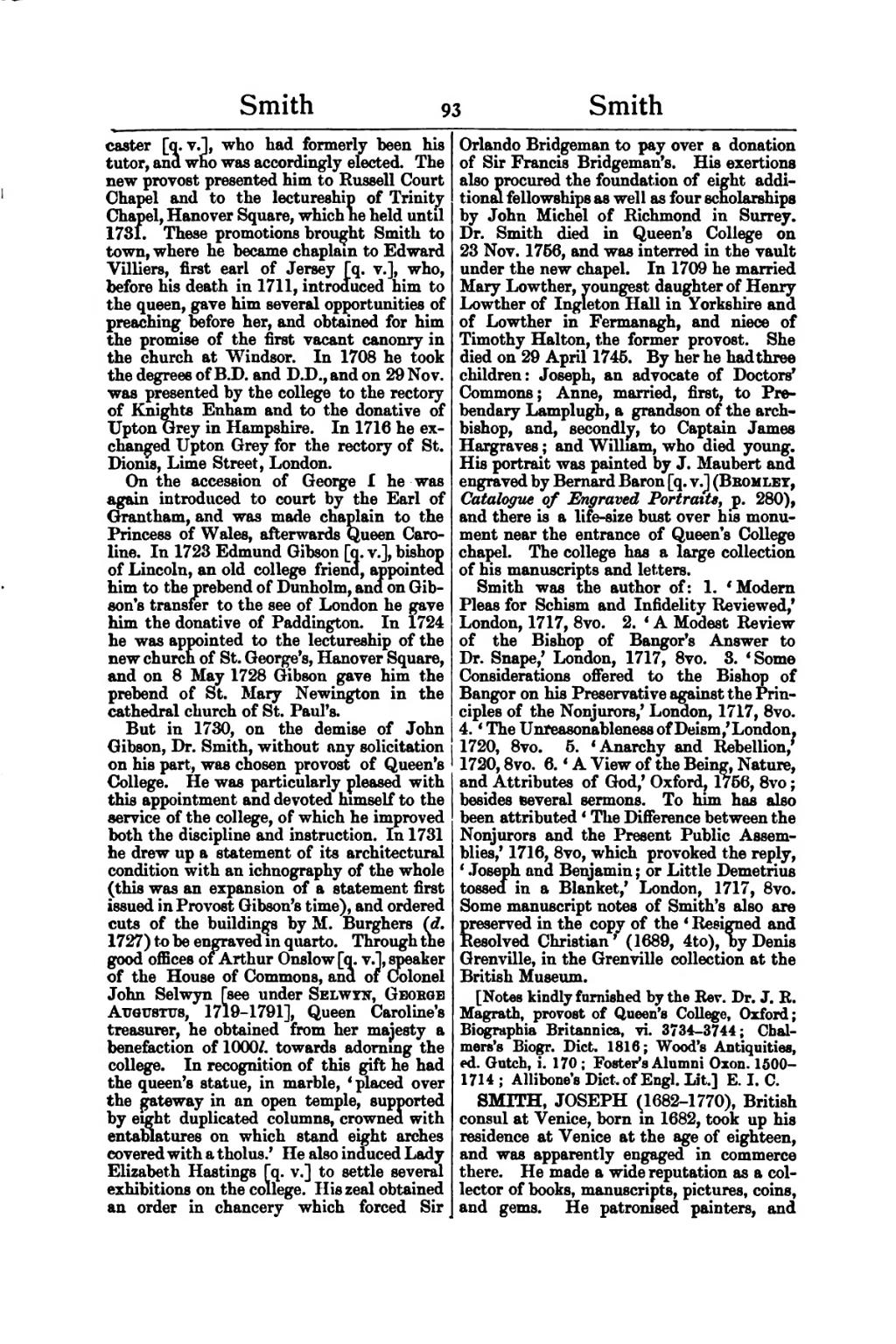caster [q. v.], who had formerly been his tutor, and who was accordingly elected. The new provost presented him to Russell Court Chapel and to the lectureship of Trinity Chapel, Hanover Square, which he held until 1731. These promotions brought Smith to town, where he became chaplain to Edward Villiers, first earl of Jersey [q. v.], who, before his death in 1711, introduced him to the queen, gave him several opportunities of preaching before her, and obtained for him the promise of the first vacant canonry in the church at Windsor. In 1708 he took the degrees of B.D. and D.D., and on 29 Nov. was presented by the college to the rectory of Knights Enham and to the donative of Upton Grey in Hampshire. In 1716 he exchanged Upton Grey for the rectory of St. Dionis, Lime Street, London.
On the accession of George I he was again introduced to court by the Earl of Grantham, and was made chaplain to the Princess of Wales, afterwards Queen Caroline. In 1723 Edmund Gibson [q. v.], bishop of Lincoln, an old college friend, appointed him to the prebend of Dunholm, and on Gibson's transfer to the see of London he gave him the donative of Paddington. In 1724 he was appointed to the lectureship of the new church of St. George's, Hanover Square, and on 8 May 1728 Gibson gave him the prebend of St. Mary Newington in the cathedral church of St. Paul's.
But in 1730, on the demise of John Gibson, Dr. Smith, without any solicitation on his part, was chosen provost of Queen's College. He was particularly pleased with this appointment and devoted himself to the service of the college, of which he improved both the discipline and instruction. In 1731 he drew up a statement of its architectural condition with an ichnography of the whole (this was an expansion of a statement first issued in Provost Gibson's time), and ordered cuts of the buildings by M. Burghers (d. 1727) to be engraved in quarto. Through the good offices of Arthur Onslow [q. v.], speaker of the House of Commons, and of Colonel John Selwyn [see under Selwyn, George Augustus, (1719–1791)], Queen Caroline's treasurer, he obtained from her majesty a benefaction of 1000l. towards adorning the college. In recognition of this gift he had the queen's statue, in marble, ‘placed over the gateway in an open temple, supported by eight duplicated columns, crowned with entablatures on which stand eight arches covered with a tholus.’ He also induced Lady Elizabeth Hastings [q. v.] to settle several exhibitions on the college. His zeal obtained an order in chancery which forced Sir Orlando Bridgeman to pay over a donation of Sir Francis Bridgeman's. His exertions also procured the foundation of eight additional fellowships as well as four scholarships by John Michel of Richmond in Surrey. Dr. Smith died in Queen's College on 23 Nov. 1756, and was interred in the vault under the new chapel. In 1709 he married Mary Lowther, youngest daughter of Henry Lowther of Ingleton Hall in Yorkshire and of Lowther in Fermanagh, and niece of Timothy Halton, the former provost. She died on 29 April 1745. By her he had three children: Joseph, an advocate of Doctors' Commons; Anne, married, first, to Prebendary Lamplugh, a grandson of the archbishop, and, secondly, to Captain James Hargraves; and William, who died young. His portrait was painted by J. Maubert and engraved by Bernard Baron [q. v.] (Bromley, Catalogue of Engraved Portraits, p. 280), and there is a life-size bust over his monument near the entrance of Queen's College chapel. The college has a large collection of his manuscripts and letters.
Smith was the author of: 1. ‘Modern Pleas for Schism and Infidelity Reviewed,’ London, 1717, 8vo. 2. ‘A Modest Review of the Bishop of Bangor's Answer to Dr. Snape,’ London, 1717, 8vo. 3. ‘Some Considerations offered to the Bishop of Bangor on his Preservative against the Principles of the Nonjurors,’ London, 1717, 8vo. 4. ‘The Unreasonableness of Deism,’ London, 1720, 8vo. 5. ‘Anarchy and Rebellion,’ 1720, 8vo. 6. ‘A View of the Being, Nature, and Attributes of God,’ Oxford, 1756, 8vo; besides several sermons. To him has also been attributed ‘The Difference between the Nonjurors and the Present Public Assemblies,’ 1716, 8vo, which provoked the reply, ‘Joseph and Benjamin; or Little Demetrius tossed in a Blanket,’ London, 1717, 8vo. Some manuscript notes of Smith's also are preserved in the copy of the ‘Resigned and Resolved Christian’ (1689, 4to), by Denis Grenville, in the Grenville collection at the British Museum.
[Notes kindly furnished by the Rev. Dr. J. R. Magrath, provost of Queen's College, Oxford; Biographia Britannica, vi. 3734–3744; Chalmers's Biogr. Dict. 1816; Wood's Antiquities, ed. Gutch, i. 170; Foster's Alumni Oxon. 1500–1714; Allibone's Dict. of Engl. Lit.]
SMITH, JOSEPH (1682–1770), British consul at Venice, born in 1682, took up his residence at Venice at the age of eighteen, and was apparently engaged in commerce there. He made a wide reputation as a collector of books, manuscripts, pictures, coins, and gems. He patronised painters, and

